
Volume 40 - Autumn 2015
The Medieval Girdle Book
Renate Mesmer's handout that accompanied her presentation at the Guild of Book Workers Seminar in Las Vegas, October 2014
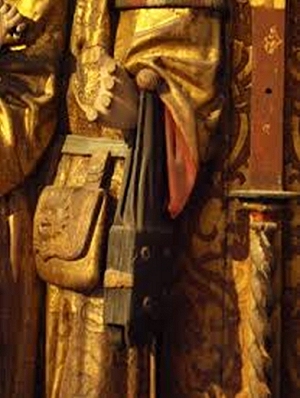
This handout was written as a tool for Renate's presentation at the Guild of Book Workers Standards of Excellence seminar, October 2015, in Las Vegas. The information in the handout covers all aspects of making a girdle book model, but is not meant as a step-by-step manual on how to make a model.
Introduction ¹
 Girdle books were small portable books worn by medieval European monks, clergyman and aristocratic nobles as a popular accessory to medieval attire between the 13th and 16th centuries. They consisted of a book whose leather binding continued loose below the cover of the book in a long tapered tail with a large knot at the end which could be tucked into one's girdle or belt. The knot was usually strips of leather woven together for durability. The book hung upside down and backwards so that when swung upwards it was ready for reading. The books were normally religious: a cleric's daily Office, or for lay persons (especially women) a Book of Hours. One of the best known texts to become a girdle book is Boethius's Consolation of Philosophy, although it is the only surviving philosophical/theological girdle book. Women especially wore the girdle book out of convenience since it was already fashionable, at least in the 15th century, to wear a girdle belt above the waistline. A book secured on the girdle belt served both the utilitarian function of enabling hands-free carrying and protecting valuable books from theft and the elements. It also made a visible statement of social position wealth and learning (or at least literacy). Authoritative figures, saints or apostles like St. Jerome were often depicted holding girdle books. Artistic depictions of the girdle book confirm their popularity as an accessory.
Girdle books were small portable books worn by medieval European monks, clergyman and aristocratic nobles as a popular accessory to medieval attire between the 13th and 16th centuries. They consisted of a book whose leather binding continued loose below the cover of the book in a long tapered tail with a large knot at the end which could be tucked into one's girdle or belt. The knot was usually strips of leather woven together for durability. The book hung upside down and backwards so that when swung upwards it was ready for reading. The books were normally religious: a cleric's daily Office, or for lay persons (especially women) a Book of Hours. One of the best known texts to become a girdle book is Boethius's Consolation of Philosophy, although it is the only surviving philosophical/theological girdle book. Women especially wore the girdle book out of convenience since it was already fashionable, at least in the 15th century, to wear a girdle belt above the waistline. A book secured on the girdle belt served both the utilitarian function of enabling hands-free carrying and protecting valuable books from theft and the elements. It also made a visible statement of social position wealth and learning (or at least literacy). Authoritative figures, saints or apostles like St. Jerome were often depicted holding girdle books. Artistic depictions of the girdle book confirm their popularity as an accessory.
Girdle books first appeared in the late 13th century and gained popularity through the 15th sometimes becoming ostentatious jewel-encrusted presentation books and falling out of favour late in the 16th century, when printed books had become much more common. Another possible reason for their decline was the relatively small number of specialized girdle-protected texts becoming outdated with little need to replace them. In an environment of increasingly cheap printing it was simpler to replicate texts than spend time preserving individual manuscripts. The intricately constructed girdle bindings were simply impractical after a certain point.
There are hundreds of artistic representations of girdle books. Their popularity in art indicates a much wider distribution and adoption of the girdle book as a binding than surviving copies suggest. A list of 150 examples "shows the proportion of representation in painting and in sculpture [as] almost equal." However, only 23 medieval girdle books have survived in their original binding, the oldest datable example being from Kastl, Germany (ca. 1453). At least part of the reason for the small number of surviving examples stems from the fact that the use of the girdle book was largely confined to a narrow area from the Netherlands to the Upper Rhine Valley.
Girdle books were a variant on other forms of medieval bookbinding in which the leather or cloth continued loose beyond the edges of the hard cover. Especially for small personal books like the Book of Hours, the leather often extended sideways, which gave extra protection for the book when not in use - the loose edges could be wrapped round, and often buckles or laces enabled the book to be securely closed. In addition, when reading, the book could be held from outside the cover, so that the clean inside surface of the leather, rather than the thumbs of the reader, touched the pages. This stopped the pages acquiring the dirty patches in the lower margins that many medieval books have. These too are often shown in art, although it is noticeable that readers are often not making full use of the protective way of holding the book. The knot used for the handle was a Turk's head knot, so named for similar appearance to the turbans worn by medieval Muslims of the Turkish Empire. Sometimes the girdle book had a hook that fastened to the belt; "a hinge connected the hook to the flap of the binding, allowing maximal movement of the book while it was still attached."
Many girdle books were unadorned; however, there are also many that have brass corner pieces, carvings, awl punctures, artisan clasps, and possibly a family crest or other mark on the front. Given the security afforded by carrying the book around, it was less risky to add decoration and gilding to a book less easily stolen than a shelved manuscript. Additionally, ornate metal clasps and hinges were more durable than woven leather or cloth bindings that wore out more quickly from heavy use.
¹ From Wikipedia
Making a Girdle Book Model with one Clasp
| Dimensions | Textblock: 9 x 13.5 cm |
| Wooden boards: 9.7 x 14.7 cm | |
| Materials | Textblock |
| Sewing thread | |
| Sewing support (cord, or alum tawed) | |
| Deer skin or soft leather | |
| Leather or vellum hinges (optional) | |
| Wooden boards (beech, or white oak) | |
| Brass 0.8 and 0.3 mm thickness, brass nails, or brass rods | |
| Twine, hemp or sisal (approx. 1mm in diameter) for Turk's head knot base | |
| Leather strips (approx. 2-3 mm wide and as long as possible) for Turk's head knot |
Textblock
Add one section at from and back to the textblock from the same paper or similar paper. Traditionally it would have been a similar paper.
Pare leather hinges which will be hinged around the first and last section.
 |
- Split the leather to approx. 0.4 - 0.5 mm thickness |
 |
- Bevel and feather along one long side (this part wraps around the section) |
 |
- Bevel the other long side in a long and flat angle (this part will go onto the board) |
| - Feather the very edges at head and tail |
Endpaper

Sewing

Double Raised Cords all-along all-along packed
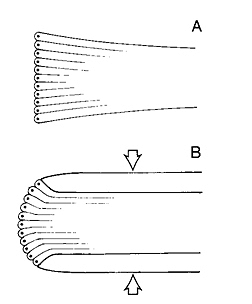 |
A perfectly sewn textblock will fall into a nice 45° shoulder. No backing should be needed. |
Spine lining

| Primary Endband (with a back bead) ² |
² photos by Renate Mesmer |
|
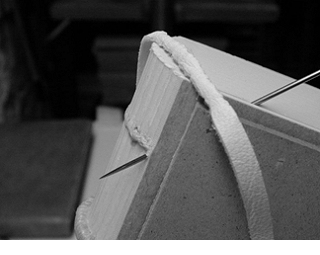 |
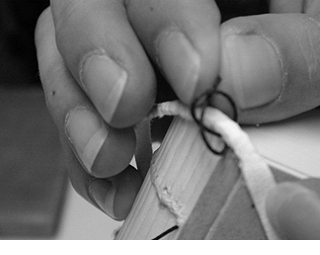 |
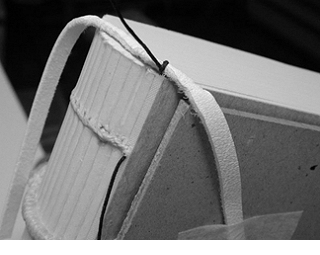 |
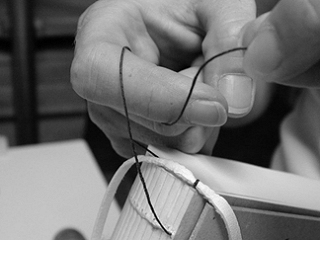 |
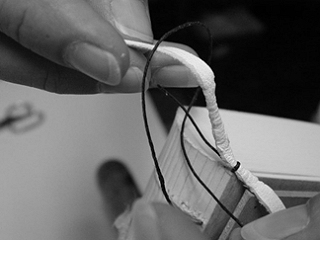 |
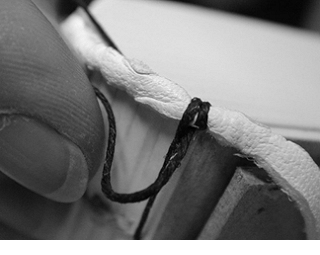 |
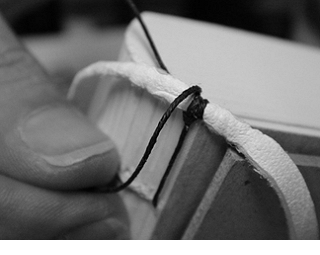 |
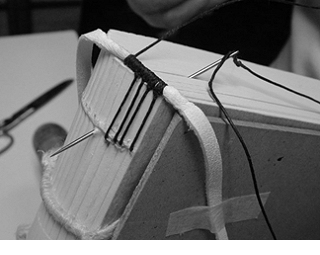 |
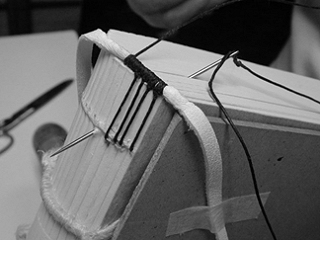 |
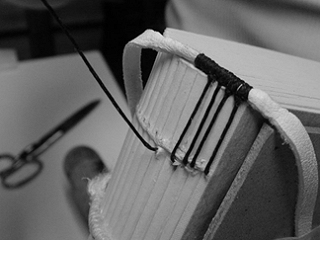 |
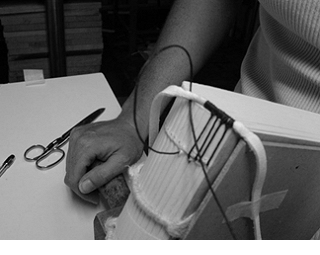 |
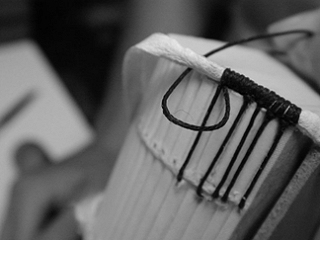 |
The Wooden Boards ♠
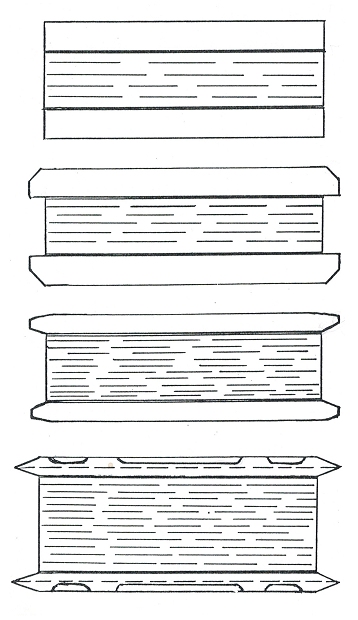 |
The oldest codices were bound in wooden boards made from oak. Oak is extremely sturdy, hard and durable and is less likely to be infested from insects. Since the 11th century beech wood was also used, and was mostly used in the northern areas of Germany in the 15th century. In the 14th century the wooden boards which often were left uncovered are starting to be covered. First half and then full leather or alum-tawed coverings, or sometimes parchment as well. In the 16th century paper boards start to take over in the binding world. |
Preparing the boards ♥
- Mark your boards: front, back, inside, outside, spine edge, head and tail
 |
Sand or file head and tail so they are not too square. |
 |
With pencil mark the centre of the thickness of the board on all four edges. |
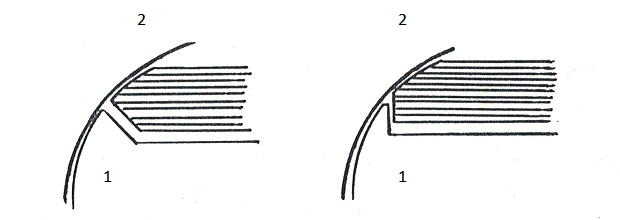 |
Shape the spine edge to fit the shape of the shoulder and 2. carry the shape of the spine onto the board. |
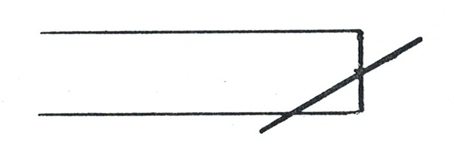 |
Use a plane to bevel the squares at head, tail and foredge to create a nice straight facet on the inside of the board |
 |
Finished shape of a board |
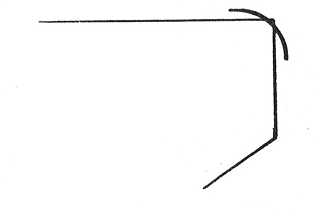 |
Sand the outside edges of all three sides |
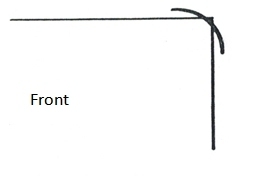 |
Sand the corners and round them just a little |
 |
Round the back corner |
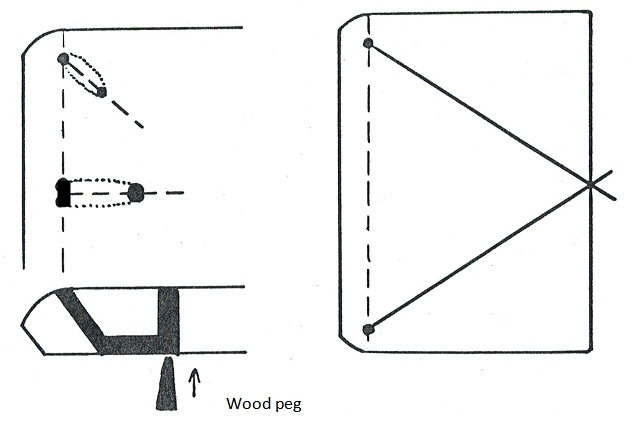 |
Mark the holes and channels for the sewing supports. Drill holes and carve out the channels |
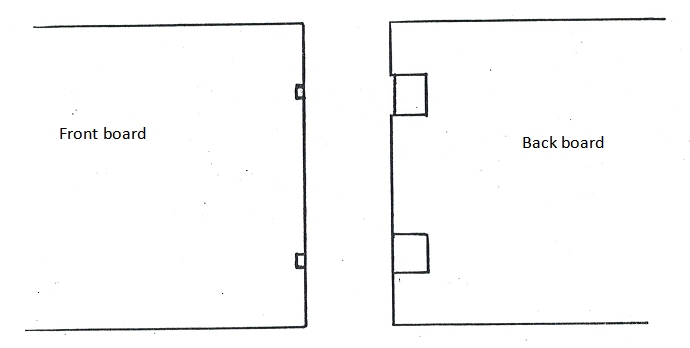 |
Cut-outs for the clasps |
♠/♥ From Dag Ernst Petersen: Notizen zum Beutelbuch, 1989 |
|
Attaching the boards
Put a spacer in front and back that creates room for the leather hinges and the turn-ins. The thickness of the spacer depends on the thickness of your leather hinges and turn-ins.
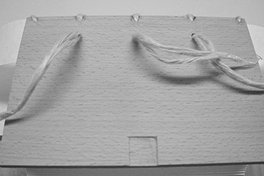 |
Lace cords through the board |
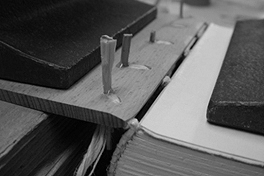 |
Use pegs to secure the cords |
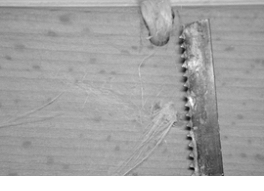 |
Cut off pegs |
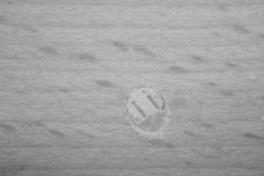 |
Sand the pegs |
Covering with Leather
- Prepare a strip of leather which will cover the tail of the book. It can be rather thin and should be feathered to 0.00 on the side that goes on the outside of the board so it won't show under the leather covering.
- Measure and cut the leather for a full cover with an extended tail (approx. 2.5 -3 times the height of the book). Make sure the extended tail has an appropriate length!
- Turn-ins should be approx. 3cm on each side. Remember: no turn-in on the tail end of the book!
- Dampen the leather, apply paste, let rest, remove paste, apply fresh paste.
- Cover your book.
- Tie-up your book in the press.
This diagram shows how to make the cut for a turn-in over laced through endbands.
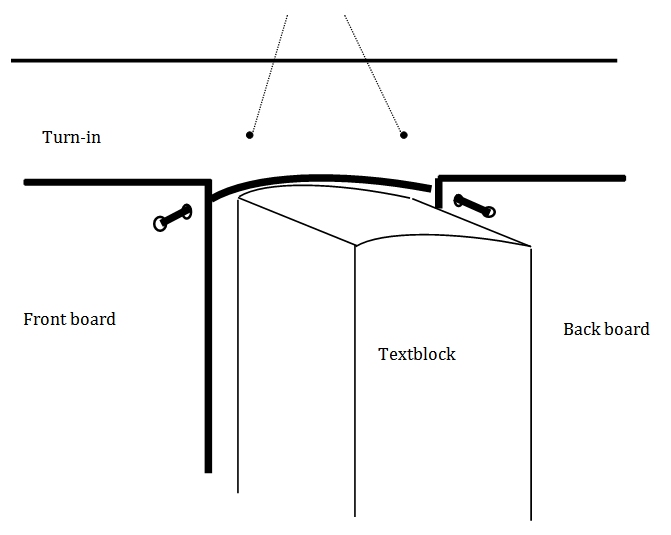
The Clasps ˜
The clasps are made from brass which is a combination of copper (Cu) and Zinc (Zn). CuZn37% has approximately 37% Zinc in the alloy. At this percentage brass can be formed cold.

1 Catch, 2+3 Hook and hook plate (back side), 4 Strap and 5 Strap plate
- Draw a design of choice on paper
- Heat the brass and quickly immerse it in cold water
- Adhere the paper design to the brass plate and cut a strip of brass the width of your design
- Cut out the clasp, file sand and maybe decorate
- Cut metal plate
- Drill holes for nails
- Polish clasp
- Expose to ammonia vapour in a small chamber for patina (optional)
- Attach clasps to the book
˜ From Dag Ernst Petersen: Notizen zum Beutelbuch, 1989
The Catch ‡
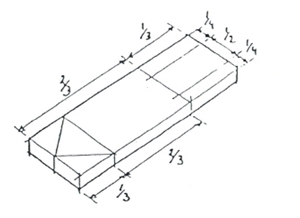 |
The proportions shown here are traditional proportions but can vary from binder to binder. |
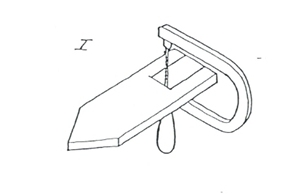 |
Using a jeweller's saw |
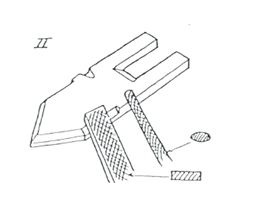 |
The use of various shapes of metal files to create the decorative profile on the edges of the clasp. |
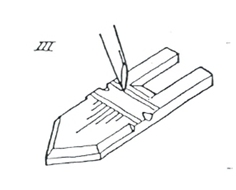 |
Decorating the surface |
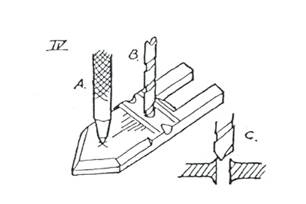 |
Mark the position of the hole. Drill hole. Soften rough edges around hole with larger drill bit. |
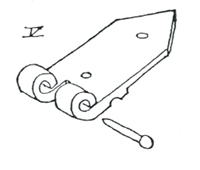 |
Making the catch. |
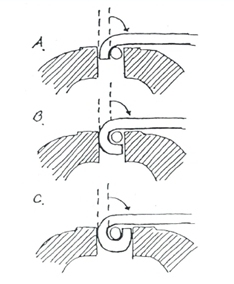 |
Rolling the ends |
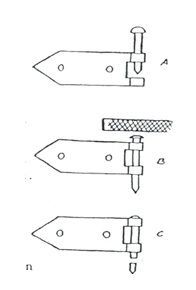 |
Inserting the brass nail. Flatten the head of the nail before fully inserting. Cut the end of the rivet. |
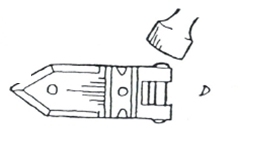 |
|
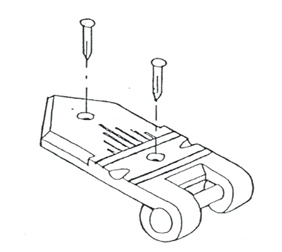 |
‡ Drawings are from: Schliessenanfertigung, Workshop Ascona, Switzerland (originally in German).
Herstellen neuer Schliessen. Translated into English by Renate Mesmer
The Leather Strap
The leather strap should be made before cutting out the space for it in the boards. There are a variety of straps:
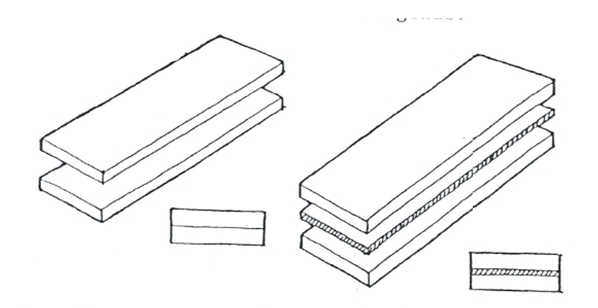
leather/leather leather/parchment/leather
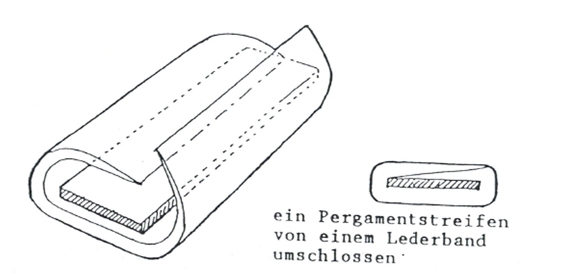
Parchment wrapped in leather
The Hook
 |
Like the catch, the shown proportions are traditional, but can vary from binder to binder. Note: the narrower the actual hook, the less strong it will be and might bend open. |
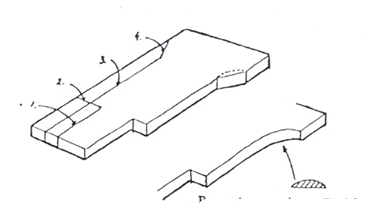 |
All straight lines will be cut with a jeweller's saw. Rounded edges can be cut with the jeweller's saw or can also be filed. This very much depends on the shape of the clasp. Use half round file to create this profile. |
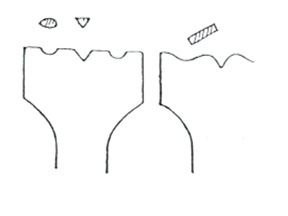 |
A variety of files in different shapes can be use to create a great variety of profiles and designs. Decorative lines are done with an engraver's tool. |
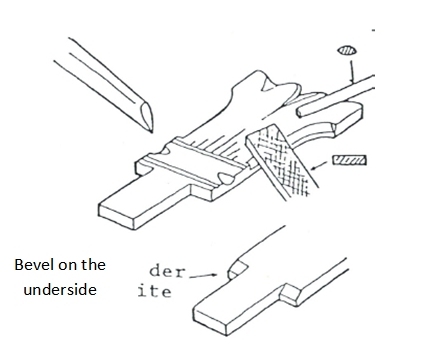 |
|
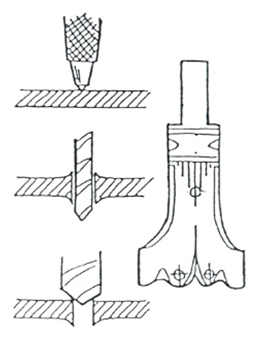 |
Mark the position of the hole. Drill hole. Soften rough edges around hole with larger drill bit. |
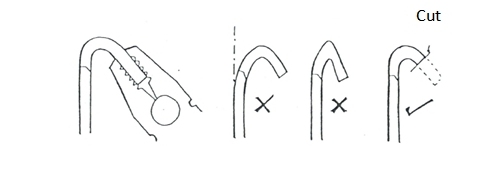 |
Bending the actual hook |
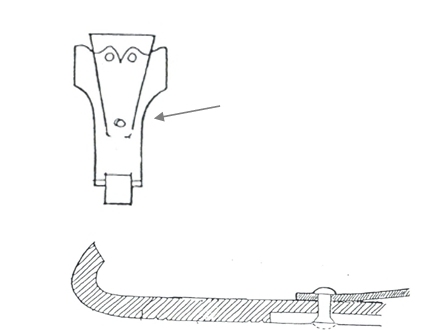 |
To attach the hook part to the leather strap a thin brass plate (0.3mm thick) needs to be cut and attached. The plate will be attached with one nail at the top first. Should the head of the nail distract the design of the clasp, it can be flattened with a file. |
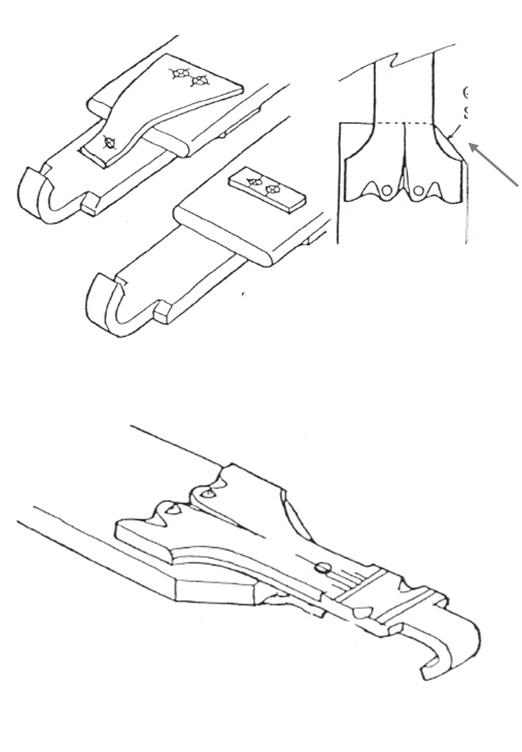 |
The leather strap is attached with two nails between the hook part and the plate. The corners of the leather strap will be cut off. The strap is never cut along the clasp! |
The Turk's Head Knot
Wrap some twine around the end of the extended leather tail. Use gelatin to keep twine from moving. Form a ball or oval shape end. Cut leather strips (approx. 2-3 mm wide). Length doesn't matter since you can easily add another piece on to it by beveling the ends and joining the two pieces with paste or PVA
Making the Turk's head knot will take some practice to get it right. Some people say it is easier to keep both ends long.
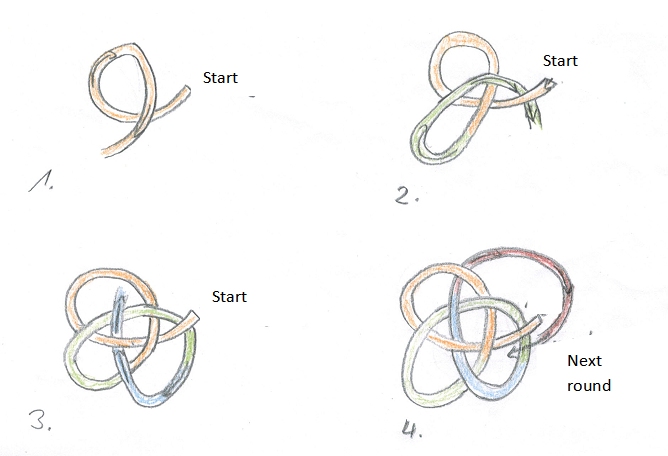
Once you got this 4-loop shape lay it over the ball spread it out evenly. Follow the pattern and cover the ball!
Literature
- Adler Georg: Handbuch Buchverschluss und Buchbeschlag; Reichert Verlag Wiesbaden 2010
- Das Beutelbuch in der bildenden Kunst. Ein beschreibendes Verzeichnis. Ergänzungen
- Alker, Hugo - Alker, Lisl. (1978) - In: Gutenberg-Jahrbuch Bd. 53 (1978) S. 302-308
- Dressler, Fridolin. (1958): Ein unbeachtetes Beutelbuch-Original. - In: Gutenberg-Jahrbuch Bd. 33 (1958) S. 268-270
- Duerrfeld, E.B.: Mit Haken und Oesen; Restauro Heft 6, 1993, page 424.
- Mowery, J.F.: Clasp, Schliessen, Clausuren; A guide to the manufacture and the literature of clasps. Guild of Bookworkers Journal Volume XXIX, Number 2, Fall 1991
- Müller, Klaus. - Landau-Nußdorf (1998): Das Beutelbuch: vom mittelalterlichen Stundenbuch zum außergewöhnlichen Gästebuch
- Neumüllers-Klauser, Renate. (1963): Ein Beutelbuch aus Isny; In: FS Carl Wehmer S. 139-146
- Neumüllers-Klauser, Renate; Oppitz, Ulrich-Dieter. (1995) - In: Anzeiger des Germanischen Nationalmuseums (1995) S. 77-92; Beutelbuch-Darstellungen in der Kunst der Spätgotik
- Sácková vazba v heraldice. [Das Beutelbuch in der Heraldik]
- Pokorný, Pavel R.(2004) - In: Heraldická rocenka (2001/02) S. 155-166
- Smith, Margit J. (2009) - In: Einbandforschung Bd. 24 (2009) S. 11-22
- Anna, Katharina, Dorothea und Margarethe: das Beutelbuch im Besitz von vier Frauen des Mittelalters
- Smith M., Bloxam, J.: The Medieval Girdle Book Project, The International Journal of the Book, Volume 3, Number 4
- Szirmai L.A.: The Archaelogy of Medieval Bookbinding, Ashgate 1999, ISBN-0 85967 904 7
- Medieval Manuscript: Bookbinding Terms, Materials, Methods and Models.
https://travelingscriptorium.files.wordpress.com/2013/07/bookbinding-booklet.pdf
- Villinger, Carl Johann Heinrich. (1959): Eine Beutelbuch-Darstellung in einem Wormser Altarschrein- In: Gutenberg-Jahrbuch Bd. 34 (1959) S. 233
Renate Mesmer - is Head of Conservation at the Folger Shakespeare Library in DC. Renate is an experienced book and paper conservator with more than twenty years experience in the field. She formally trained as a master bookbinder in Germany and has pursued further conservation training at renowned institutions throughout Europe and the U.S. She has held previous positions conserving and restoring books and manuscripts at the Munich State Archives; the University Library in Mannheim; the Speyer State Archives in Germany, and at the Centro del bel libro in Ascona, Switzerland.
